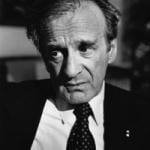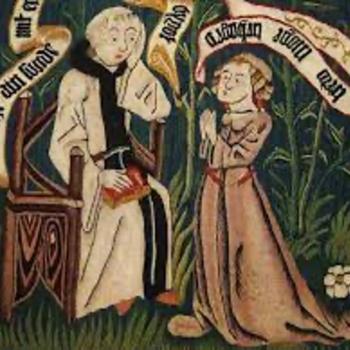Several years ago, a Latter-day Saint friend encouraged me to read British Methodist theologian Margaret Barker’s books. Now I understand why.
 A cautionary note. Barker has a large corpus of books to her credit, including The Great Angel: A Study of Israel’s Second God and The Great High Priest: The Temple Roots of Christian Liturgy. I have only read her much briefer summary, Temple Theology: An Introduction. Not being a biblical scholar or a scholar of either ancient Judaism or early Christianity, I am not prepared to critique Barker’s work. As far I know, her most significant arguments have not found broad support outside of Mormon circles.
A cautionary note. Barker has a large corpus of books to her credit, including The Great Angel: A Study of Israel’s Second God and The Great High Priest: The Temple Roots of Christian Liturgy. I have only read her much briefer summary, Temple Theology: An Introduction. Not being a biblical scholar or a scholar of either ancient Judaism or early Christianity, I am not prepared to critique Barker’s work. As far I know, her most significant arguments have not found broad support outside of Mormon circles.
Analyzing biblical texts, a broad range of pseudepigrapha (such as the Book of Enoch), and an equally broad range of early Christian sources, Barker argues that “the original gospel message was about the temple, not the corrupted temple of Jesus’ own time, but the original temple which had been destroyed some six hundred years earlier.” The “original temple” in Jerusalem was that built by massive conscripted labor under King Solomon and stood until its destruction at the hands of the Babylonians in the early sixth century BC. Barker labels this lost building “Melchizedek’s temple.” When the Persian Empire allowed the Jews to rebuild their temple, the Second Temple — dedicated around 516 BC — lacked key items such as the Ark of the Covenant, previously in the Holy of Holies. The Second Temple had a tumultuous history, desecrated by the Syrians and then rededicated by the Maccabees in the second century. Shortly before Jesus’s birth, Herod the Great massively expanded and rebuilt the temple. Roman authorities then destroyed the temple in the year 70 CE after the failed Jewish revolt.

Barker argues that “the temple roots of Christianity” explain the rapid acceptance by some first-century Jews of Jesus as the Son of God. Many scholars believe that the ancient Israelite journey to monotheism was long and gradual and incomplete until after the destruction of the first temple. Barker argues that earlier Israelite religion had known as at least three gods: the God Most High, Yahweh, and El Shaddai, the latter being a divine Mother and wisdom of God. Thus, an ancient Israelite Trinity of Father, Son, and Mother. According to Barker, King Josiah attempted to stamp out these ancient practices and beliefs and replace them with “the ‘Moses’ religion and the Aaron priesthood.” Barker notes the presence of “hundreds of small female figurines” found in Judah, which she believes relate to the worship of a goddess connected to Asheratah, the Great Lady of Ugarit.
However, Josiah’s purge was only partly successful, leaving Jews expecting the appearance of a Son of God in the order of Melchizedek, a high priest who could “carry away the sin and uncleanness of the people.” Moreover, those Jews whose faith focused on the older temple reviled Herod’s temple. It is no accident that Jesus predicted its destruction. According to Barker, Jesus identified himself as the “LORD” of the scriptures (the Christian Old Testament), which is also how many early Christians understood Old Testament passages, as appearances of the pre-incarnate Savior. Thus, some Jews anticipated the messiah as “an anointed High Priest who would proclaim the kingdom and make the great atonement.” In a nutshell, there was no need for a long period of theological development or an infusion of Greek philosophy for Christians to make sense of Jesus as the Son of God.
Skipping way ahead, Barker contends that when Constantine ordered the construction of churches on Calvary and the presumed site of Jesus’s tomb (the Church of the Holy Sepulchre), the relics treasured by Christian pilgrims were connected to the first temple: King Solomon’s ring, the horn of oil, etc. (Early Christians sometimes referred to the cave they believed to be Jesus’s tomb as the “holy of holies.”
Also, Barker notes the significance of the Hagia Sophia, the Constantinople church dedicated to the Holy Wisdom, another sign for her of Christian attachment to the lost world of the first temple.
One can readily surmise why many Latter-day Saints find Barker’s work compelling.
First, I presume Mormons like the mere suggestion that the temple was of central importance to early Christians. Early Christians, like nineteenth-century Mormons, aimed to restore corrupted practices to their pure, ancient form. She suggests that “it may be that the familiar story of Eden originally described how the older priesthood had been expelled from their Eden temple, and lost access to their tree of life. Adam was remembered as the first high priest.” Latter-day Saint scriptures identify figures such as Adam and Enoch as ancient believers in Christ, with Adam having priesthood access to the same temple ordinances later corrupted, lost, and eventually restored by Joseph Smith during the 1830s and early 1840s.
Second, Barker argues that “theosis, the transformation of a human being into a divine being … was at the heart of the temple tradition, together with the belief in a resurrected anointed one, a resurrected Messiah.” The high priests who stood in the holy of holies became angels, were “resurrected, and then sent back to earth.” This ancient idea of theosis correlates with the Latter-day Saint doctrine that human beings obedient to divine commandments and ordinances can become like God. Joseph Smith’s 1832 vision of three tiers of heavenly glory promised that those who reach the celestial kingdom would be “gods, even the sons of Gods.” Brigham Young once pithily summarized the Mormon belief in the essential similarity between God the Father and men: “As he was, so are we now / As he is now, so we shall be.”
Third, Barker’s emphasis on divine wisdom as a separate deity within ancient Judaism resonates to some extent with the Mormon belief in a Heavenly Mother. Latter-day Saints tend reverently allude to Heavenly Mother instead of worshiping her, praying to her, or even describing her divine role in any detail. More generally, Barker’s conclusions conform much more readily to the Latter-day Saint understanding of the Godhead than to Nicene Trinitarianism.
There is much more that one could say in this vein. For instance, Barker’s suggestion that the deuteronomistic editors of the Jewish scriptures removed many precious truths fits with the Latter-day Saint understanding of the Bible.
Of course, these broad correlations between Barker’s temple theology and Mormon doctrine do not mean that they cohere in the details. That early Christians or ancient Israelites believed in theosis (and one can find New Testament passages and many quotes from early Christian theologians to support the concept) does not mean that the Mormon doctrine of theosis exactly resembles what those early Christians believe. Nor does the fact that the temple was of great significance to early Christians mean that the Latter-day Saints restored ordinances as they were practiced by those early Christians (or by ancient Israelites). What Barker describes in terms of ancient Israelite worship of El Shaddai / Wisdom is nearly as foreign to contemporary Mormonism as it is to other contemporary streams of Christianity.












